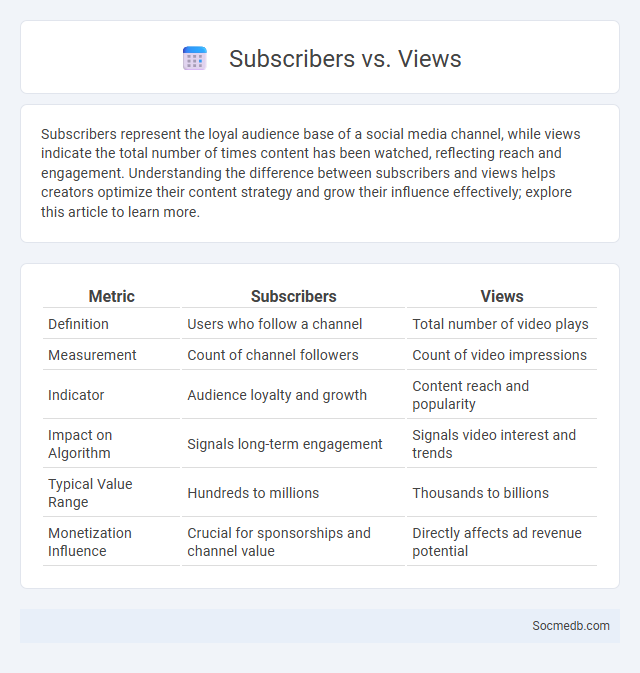
Photo illustration: Subscribers vs Views
Subscribers represent the loyal audience base of a social media channel, while views indicate the total number of times content has been watched, reflecting reach and engagement. Understanding the difference between subscribers and views helps creators optimize their content strategy and grow their influence effectively; explore this article to learn more.
Table of Comparison
| Metric | Subscribers | Views |
|---|---|---|
| Definition | Users who follow a channel | Total number of video plays |
| Measurement | Count of channel followers | Count of video impressions |
| Indicator | Audience loyalty and growth | Content reach and popularity |
| Impact on Algorithm | Signals long-term engagement | Signals video interest and trends |
| Typical Value Range | Hundreds to millions | Thousands to billions |
| Monetization Influence | Crucial for sponsorships and channel value | Directly affects ad revenue potential |
Understanding Subscribers: Core Metrics & Significance
Analyzing social media subscribers involves tracking core metrics such as subscriber growth rate, engagement rate, and churn rate to gauge audience loyalty and content effectiveness. Understanding these metrics helps businesses tailor content strategies, improve user retention, and maximize return on investment (ROI) through targeted marketing efforts. Subscriber insights influence algorithm prioritization, enhancing organic reach and brand visibility across platforms like Instagram, YouTube, and TikTok.
The True Value of YouTube Views Explained
YouTube views serve as a key metric reflecting the reach and popularity of video content, influencing content creators' revenue through ad monetization and brand partnerships. High view counts boost channel credibility, enhancing discoverability via YouTube's algorithm and increasing organic traffic. Understanding the true value of views involves recognizing their role in engagement metrics, audience retention, and long-term channel growth.
Analytics Dashboards: Navigating Your Data
Analytics dashboards provide a centralized platform to visualize key social media metrics such as engagement rates, follower growth, and content reach in real-time. These dashboards enable marketers to track performance trends, identify successful campaigns, and adjust strategies based on data-driven insights. Integrating tools like Google Analytics, Facebook Insights, and Twitter Analytics enhances decision-making by offering comprehensive overviews of audience behavior and campaign effectiveness.
Subscribers vs Views: Key Differences
Subscribers represent the loyal audience who have actively chosen to follow a social media channel, indicating long-term interest and engagement. Views measure the total number of times content is watched, reflecting reach and immediate popularity but not necessarily commitment. Understanding the balance between subscribers and views helps creators tailor content strategies to grow both sustained audience and broad visibility.
How Analytics Dashboards Track Engagement
Analytics dashboards track social media engagement by collecting real-time data on user interactions such as likes, shares, comments, and clicks across multiple platforms. These tools use metrics like engagement rate, reach, and impressions to provide actionable insights into audience behavior and content performance. Advanced dashboards integrate machine learning algorithms to identify trends and optimize posting strategies for maximum impact.
The Impact of Algorithm on Subscribers and Views
Algorithm-driven content curation significantly influences subscriber growth and view counts by prioritizing personalized recommendations based on user behavior and engagement patterns. Platforms like YouTube and Instagram employ machine learning models to analyze watch time, click-through rates, and interaction history, directly affecting content visibility and audience retention. As a result, creators experience fluctuating exposure levels, emphasizing the need for strategic optimization to align with algorithmic preferences and maximize reach.
Interpreting Subscriber Growth Through Analytics
Analyzing subscriber growth on social media platforms involves tracking metrics such as follower count, engagement rate, and demographic insights over time. Utilizing analytics tools like Google Analytics, Facebook Insights, or YouTube Studio provides valuable data on user behavior, content performance, and growth patterns. Interpreting these analytics enables targeted content strategies that enhance subscriber retention and attract new followers.
Leveraging Views Data for Content Strategy
Leveraging views data is crucial for refining social media content strategy by identifying high-performing posts and audience preferences. Analyzing engagement metrics such as view duration and shares enables tailored content creation that maximizes reach and interaction. Utilizing platform-specific insights from tools like Instagram Analytics and YouTube Studio ensures strategic optimization aligned with real-time audience trends.
Role of Real-Time Analytics in Channel Performance
Real-time analytics provide immediate insights into social media channel performance by tracking user engagement, click-through rates, and content reach as events unfold. These data-driven metrics enable marketers to optimize campaigns promptly, enhancing audience targeting and maximizing return on investment. Leveraging tools like social listening and sentiment analysis allows brands to adapt strategies dynamically, improving overall channel effectiveness and responsiveness.
Making Data-Driven Decisions: Integrating Subscribers, Views & Analytics
Leveraging social media analytics enables precise tracking of subscribers, views, and engagement metrics, empowering marketers to make data-driven decisions that optimize content strategy. By integrating platform-specific subscriber growth and detailed viewership patterns, businesses can identify trends and tailor campaigns to target audience behavior. Utilizing comprehensive analytics dashboards streamlines the evaluation of key performance indicators (KPIs), fostering informed adjustments that maximize reach and conversion rates.
 socmedb.com
socmedb.com